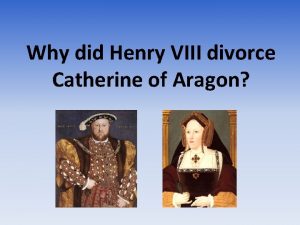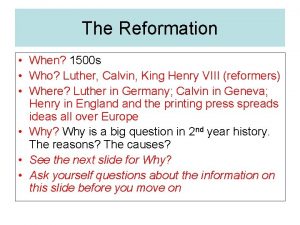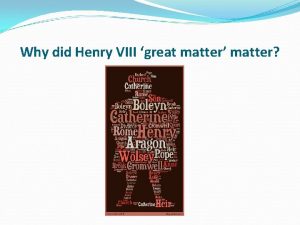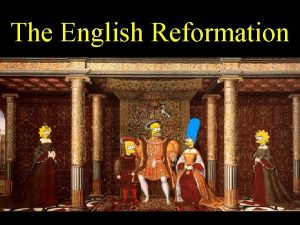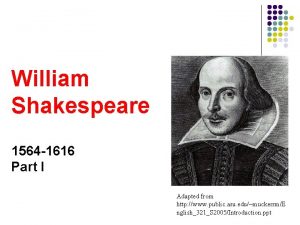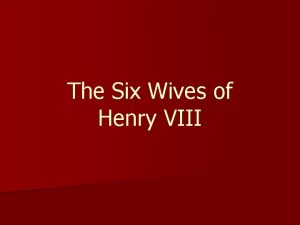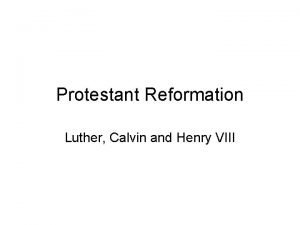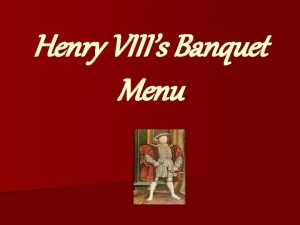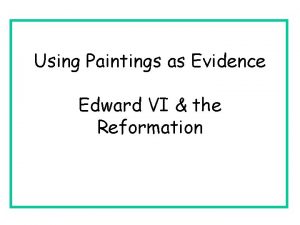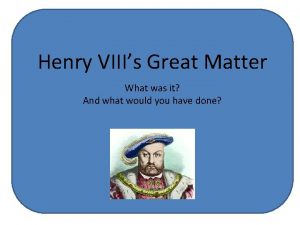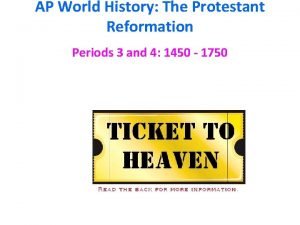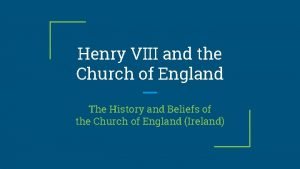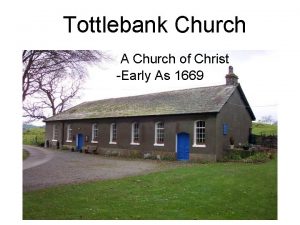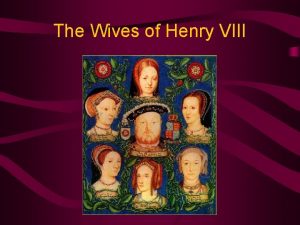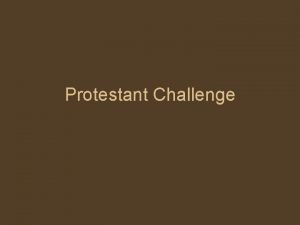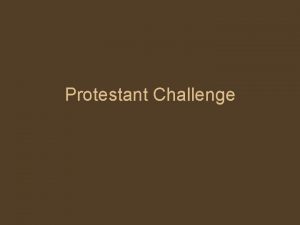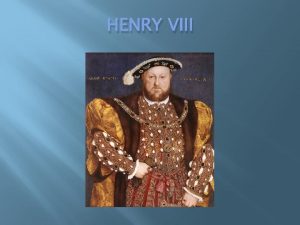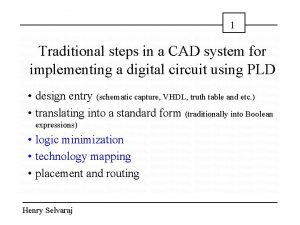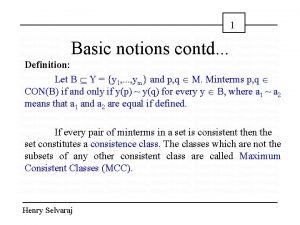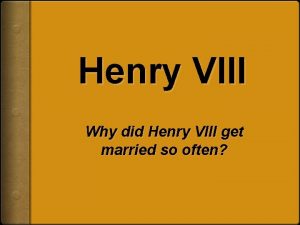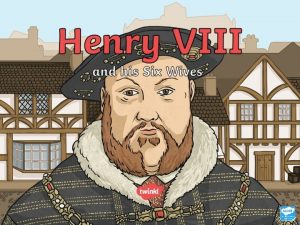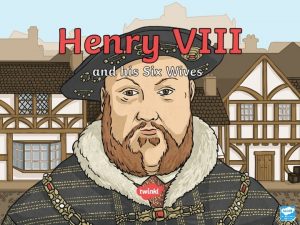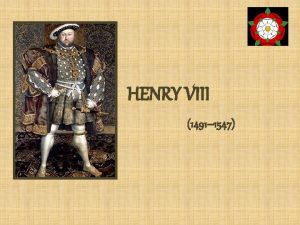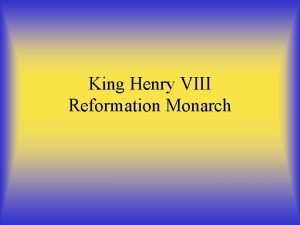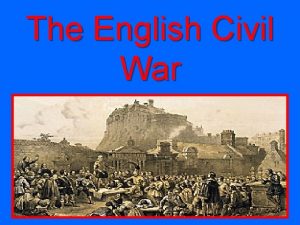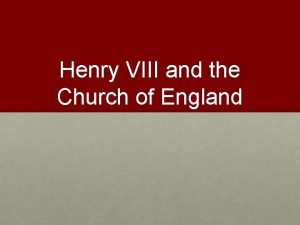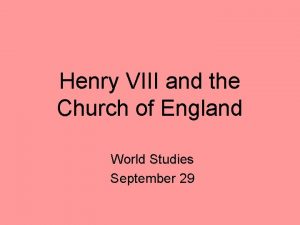England Henry VIII Henry VIII creates the Church



































- Slides: 35

England

Henry VIII • Henry VIII creates the Church of England (WHY? ) with Parliament’s help • Henry VIII is married 6 times; has 3 surviving children (Mary, Elizabeth, Edward) • Upon his death, Edward takes the throne (very Protestant!)

• When Edward dies, Mary becomes queen of England (very Catholic!) • Mary dies without an heir; Elizabeth becomes queen (Protestant)

Queen Elizabeth I • Makes England a Protestant country • Solidifies to Scotland & Ireland • Made England one of the most powerful nations in Europe

England’s Religious Rollercoaster! Henry VIII - Catholic Henry VIII- Protestant Edward VI Protestant Queen Mary-Catholic Elizabeth I- Protestant

• When Elizabeth dies, the Tudor Dynasty ends • James (VI) I of Scotland becomes king; begins the Stuart Dynasty • Trouble ahead…. Heyyyy!

ENGLISH CIVIL WAR The English Civil War





The Beginning of Trouble • Started when James I took the throne after Elizabeth died • Believed he had divine right • His greatest weakness: – always asking Parliament for money to fund his extravagant lifestyle ; WHAT IS PARLIAMENT? • Parliament and the people were not always happy with his foreign policy

Religion vs. the Monarchy • James was head of church and state • The Puritans felt there was still too much Catholic influence in the Church of England wanted change • James felt criticism of the church meant you were not a loyal subject and you should leave – Who were the Puritans?

Charles’s Abuse of Power • Charles I, Son of James, he also believed in divine right, opposed Puritans and married a Catholic • When a request for money was denied he: – Put areas under martial law – Dissolved Parliament – Quartered troops in private homes

Charles I • He would persecute Puritans • Thousands of Puritans went on to seek religious freedom in the American colonies • Charles further angered Scotland when he tried to force Anglican prayer on them • They were prepared to defend their freedom

Beginnings of War • The Scots invaded England the Irish rebelled over the practice of land grants • Charles was in desperate need of money • He was forced to call Parliament back and they were determined to limit his power • Charles refused to agree to their demands and both sides prepared for war

English Civil War • Cavaliers those who supported Charles I; nobles and landowners from north • Roundheads supporters of Parliament and Puritans; came from south • Roundheads were led by Oliver Cromwell • 4 yrs of conflict • Parliament won and Charles was executed


England’s New Government • The Rump Parliament set up a commonwealth or a republic • This parliament proved to be ineffective over time • Cromwell placed England under military rule • When he died, people wanted a change and restored the monarch under Charles II

Representative gov’t and individual rights would be a main focus and no more absolute monarchies would reign!!!

A King returns to the Throne • Charles II: the ‘merry monarch’ – After the English Civil War & Cromwell’s 10 year rule, the Rump Parliament met to establish the English monarchy – They decide to bring back Charles II – son of Charles I: (The Restoration: 1660 -1685) – Nicknamed the ‘merry monarch’: loved parties, games; supports the arts & sciences,

• Charles’s powers are limited by a constitution (Constitutional Monarchy) • A constitution defines governmental powers, as well as the rights of the people

Political parties in Parliament • • • TORIES: Supported the “King, Defended hereditary monarchy church & land”

Political Parties in Parliament • WHIGS: • Supported “life, liberty & property” • Wanted to exclude Charles’s brother James from the throne

Parliament at work • Habeas Corpus Act: • A person cannot be held in prison without just cause or without a trial

A Catholic King? • Charles II dies in 1685: his brother James II becomes king • James II is openly Catholic; he raises a Catholic army & appoints Catholics to government positions

The Glorious Revolution: A Bloodless Revolt! • MPs (members of Parliament) want James II to die so the throne passes to his Protestant sister Mary, married to William of Orange • However, a son is born; it would be raised as a Catholic; Parliament decides to take action

• In 1688, Parliament invited Mary and her husband William to take throne of England • James II flees, and a ‘bloodless’ revolution takes place

• James II lands in Ireland • He gathers Irish Catholics in an attempt to take back the throne of England • His attempt fails & Catholics are severely punished for supporting James

William & Mary rule England • • New limits are placed on the monarchy Parliament passes a Bill of Rights Limits are placed on royal power Guaranteed certain individual rights

Parliament & the Crown • England is still a monarchy, but king or queen can’t rule without Parliament’s consent • Parliament is controlled by people of property: nobles, merchants, clergy, etc… • The English throne passes to the German Hanover family

Parliament gets stronger • Parliament’s powers increase; they appoint a cabinet & a prime minister • The German Hanover kings rely heavily on the cabinet members and the prime minister • George III becomes king in 1760 – He fights many costly wars to expand British territory in North America • How will George pay for these wars? ? Perhaps he’ll tax the American colonists…

SO Why should you care? ? ? • This period of English history is HUGELY influential to the formation of the U. S. – Ideas like a Parliament, Bill of Rights, Habeas Corpus, religious freedom, etc… are all an important part of how YOU live!

To sum up… • Tudor Dynasty: – Henry VIII Edward Mary Elizabeth I • Stuart Dynasty: – James I Charles I (beheaded) NO KING (11 yrs) Charles II James II William & Mary Anne • Hanover Dynasty: – George I, III

 Why did henry viii divorce catherine of aragon
Why did henry viii divorce catherine of aragon Luther calvin and henry viii
Luther calvin and henry viii Henry viii great matter
Henry viii great matter How to remember henry viii wives
How to remember henry viii wives How to remember king henry viii wives
How to remember king henry viii wives King henry viii gardena
King henry viii gardena King henry viii family tree
King henry viii family tree Theocracy def
Theocracy def King henry viii banquet menu
King henry viii banquet menu Henry viii deathbed painting
Henry viii deathbed painting Henry viii wives executed
Henry viii wives executed Henry viii great matter
Henry viii great matter Henry viii definition ap world history
Henry viii definition ap world history The six wives of henry viii
The six wives of henry viii Valois bourbon
Valois bourbon Henry viii foreign policy 1509-1529
Henry viii foreign policy 1509-1529 Church of england beliefs
Church of england beliefs Tottlebank church of christ in england
Tottlebank church of christ in england Môn thể thao bắt đầu bằng chữ f
Môn thể thao bắt đầu bằng chữ f Hát kết hợp bộ gõ cơ thể
Hát kết hợp bộ gõ cơ thể Khi nào hổ mẹ dạy hổ con săn mồi
Khi nào hổ mẹ dạy hổ con săn mồi Dạng đột biến một nhiễm là
Dạng đột biến một nhiễm là Nguyên nhân của sự mỏi cơ sinh 8
Nguyên nhân của sự mỏi cơ sinh 8 Phản ứng thế ankan
Phản ứng thế ankan Trời xanh đây là của chúng ta thể thơ
Trời xanh đây là của chúng ta thể thơ Chó sói
Chó sói Thiếu nhi thế giới liên hoan
Thiếu nhi thế giới liên hoan điện thế nghỉ
điện thế nghỉ Phối cảnh
Phối cảnh Một số thể thơ truyền thống
Một số thể thơ truyền thống Thế nào là hệ số cao nhất
Thế nào là hệ số cao nhất Frameset trong html5
Frameset trong html5 Sơ đồ cơ thể người
Sơ đồ cơ thể người So nguyen to
So nguyen to đặc điểm cơ thể của người tối cổ
đặc điểm cơ thể của người tối cổ Các châu lục và đại dương trên thế giới
Các châu lục và đại dương trên thế giới
